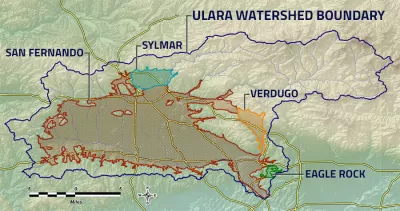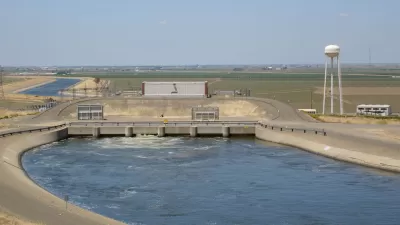The semi-arid region of Los Angeles is often mistaken for a desert, but the local water supply is also constrained by the environmental sins of the 20th century. The water supply equation of Los Angeles will soon change, however.

Hayley Smith reports for the Los Angeles Times on a major breakthrough for resilience in the nation’s second largest city: the city of Los Angeles is nearing completion on a $600 million project to restore groundwater supplies in the San Fernando Valley.
“Nearly 70% of the city’s 115 wells in the San Fernando Valley groundwater basin — the largest such basin under the purview of the Los Angeles Department of Water and Power — have been sitting unused for decades after dangerous contaminants seeped into the aquifer,” explains Smith.
The toxic plume in the city’s groundwater supply is a result of pollution from the aerospace, automobile, and defense industries of the region’s boom period in the 20th century. “The extent of the problem wasn’t fully uncovered until after the Safe Drinking Water Act of 1974 mandated increased testing and monitoring standards for drinking water,” according to the article.
The project will enable three treatment facilities to filter contaminants from the toxic plume out of the groundwater basin. Angelenos will “regain full access to up to 87,000 acre-feet of water each year, or nearly a fifth of what they consume.”
The new water supply couldn’t come at a better time, as the state and the region attempt to address the latest of a string of droughts—a trend only likely to worsen as a result of climate change. The long-term work of retrofitting the valley with permeable surfaces is not mentioned in the article.
FULL STORY: Drought-ravaged L.A. seeks surprising source of water: A contaminated Superfund site

Alabama: Trump Terminates Settlements for Black Communities Harmed By Raw Sewage
Trump deemed the landmark civil rights agreement “illegal DEI and environmental justice policy.”

Planetizen Federal Action Tracker
A weekly monitor of how Trump’s orders and actions are impacting planners and planning in America.

The 120 Year Old Tiny Home Villages That Sheltered San Francisco’s Earthquake Refugees
More than a century ago, San Francisco mobilized to house thousands of residents displaced by the 1906 earthquake. Could their strategy offer a model for the present?

Ken Jennings Launches Transit Web Series
The Jeopardy champ wants you to ride public transit.

BLM To Rescind Public Lands Rule
The change will downgrade conservation, once again putting federal land at risk for mining and other extractive uses.

Indy Neighborhood Group Builds Temporary Multi-Use Path
Community members, aided in part by funding from the city, repurposed a vehicle lane to create a protected bike and pedestrian path for the summer season.
Urban Design for Planners 1: Software Tools
This six-course series explores essential urban design concepts using open source software and equips planners with the tools they need to participate fully in the urban design process.
Planning for Universal Design
Learn the tools for implementing Universal Design in planning regulations.
Clanton & Associates, Inc.
Jessamine County Fiscal Court
Institute for Housing and Urban Development Studies (IHS)
City of Grandview
Harvard GSD Executive Education
Toledo-Lucas County Plan Commissions
Salt Lake City
NYU Wagner Graduate School of Public Service





























